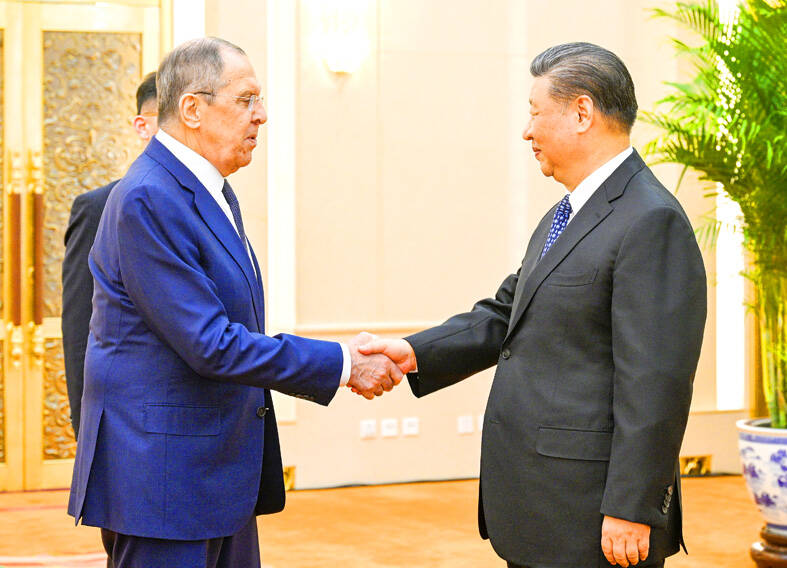China is backing Russia’s war effort in Ukraine by helping Moscow in its biggest military buildup since the Soviet era, providing drone and missile technology, satellite imagery and machine tools, senior US officials said on Friday.
However, the Chinese embassy in the US said it has not provided weaponry to any party, adding that it is “not a producer of or party involved in the Ukraine crisis.”
The officials, speaking on condition of anonymity, said US President Joe Biden raised the issue with Chinese President Xi Jinping (習近平) in their recent phone call and that it is a topic of discussion with US allies in Europe and around the world.

Photo: Xinhua news agency via AP
Chinese materials are filing critical gaps in Russia’s defense production cycle and helping Moscow undertake its “most ambitious defense expansion since the Soviet era and on a faster time line than we believed possible early on in this conflict,” one official said.
“Our view is that one of the most game-changing moves available to us at this time to support Ukraine is to persuade the PRC [People’s Republic of China] to stop helping Russia reconstitute its military industrial base. Russia would struggle to sustain its war effort without PRC input,” the official said.
Chinese embassy spokesman Liu Pengyu (劉鵬宇) said that normal trade between China and Russia should not be interfered or restricted.
“We urge the US side to refrain from disparaging and scapegoating the normal relationship between China and Russia,” Liu said.
Some of the information provided by the US officials in a small briefing with reporters was based on declassified intelligence. They sketched a wide array of ways China is helping Russia’s two-year war against Ukraine without providing lethal assistance.
Russians have likely used machine tool imports from China to increase their ballistic missile production, the officials said.
Last year, 90 percent of Russia’s microelectronics imports came from China, which Russia has used to produce missiles, tanks and aircraft, the officials said.
They said that Chinese companies such as Wuhan Global Sensor Technology Co (武漢高芯科技), Wuhan Tongsheng Technology Co Ltd (武漢同昇科技) and Hikvision Digital Technology Co (海康威視) are providing Chinese optical components for use in Russian systems, including tanks and armored vehicles.
In addition, Russia has received military optics for tanks and armored vehicles that Chinese firms iRay Technology (奕瑞科技) and North China Research Institute of Electro-Optics (華北光電技術研究所) manufacture, they said.
China has provided Russia with drone engines and turbojet engines for cruise missiles, the officials said, adding that Chinese and Russian entities have been working to jointly produce drones inside Russia.
Chinese companies are likely providing Russia with nitrocellulose to make propellants for weapons, helping Russia rapidly expand its capacity to make key munitions such as artillery rounds, they said.
China is helping Russia improve its satellite and other space-based capabilities for use in Ukraine, increasing the Russian threat across Europe, and the US has information that China is providing imagery to Russia for its war on Ukraine, they said.

AIR SUPPORT: The Ministry of National Defense thanked the US for the delivery, adding that it was an indicator of the White House’s commitment to the Taiwan Relations Act Deputy Minister of National Defense Po Horng-huei (柏鴻輝) and Representative to the US Alexander Yui on Friday attended a delivery ceremony for the first of Taiwan’s long-awaited 66 F-16C/D Block 70 jets at a Lockheed Martin Corp factory in Greenville, South Carolina. “We are so proud to be the global home of the F-16 and to support Taiwan’s air defense capabilities,” US Representative William Timmons wrote on X, alongside a photograph of Taiwanese and US officials at the event. The F-16C/D Block 70 jets Taiwan ordered have the same capabilities as aircraft that had been upgraded to F-16Vs. The batch of Lockheed Martin

GRIDLOCK: The National Fire Agency’s Special Search and Rescue team is on standby to travel to the countries to help out with the rescue effort A powerful earthquake rocked Myanmar and neighboring Thailand yesterday, killing at least three people in Bangkok and burying dozens when a high-rise building under construction collapsed. Footage shared on social media from Myanmar’s second-largest city showed widespread destruction, raising fears that many were trapped under the rubble or killed. The magnitude 7.7 earthquake, with an epicenter near Mandalay in Myanmar, struck at midday and was followed by a strong magnitude 6.4 aftershock. The extent of death, injury and destruction — especially in Myanmar, which is embroiled in a civil war and where information is tightly controlled at the best of times —

China's military today said it began joint army, navy and rocket force exercises around Taiwan to "serve as a stern warning and powerful deterrent against Taiwanese independence," calling President William Lai (賴清德) a "parasite." The exercises come after Lai called Beijing a "foreign hostile force" last month. More than 10 Chinese military ships approached close to Taiwan's 24 nautical mile (44.4km) contiguous zone this morning and Taiwan sent its own warships to respond, two senior Taiwanese officials said. Taiwan has not yet detected any live fire by the Chinese military so far, one of the officials said. The drills took place after US Secretary

THUGGISH BEHAVIOR: Encouraging people to report independence supporters is another intimidation tactic that threatens cross-strait peace, the state department said China setting up an online system for reporting “Taiwanese independence” advocates is an “irresponsible and reprehensible” act, a US government spokesperson said on Friday. “China’s call for private individuals to report on alleged ‘persecution or suppression’ by supposed ‘Taiwan independence henchmen and accomplices’ is irresponsible and reprehensible,” an unnamed US Department of State spokesperson told the Central News Agency in an e-mail. The move is part of Beijing’s “intimidation campaign” against Taiwan and its supporters, and is “threatening free speech around the world, destabilizing the Indo-Pacific region, and deliberately eroding the cross-strait status quo,” the spokesperson said. The Chinese Communist Party’s “threats